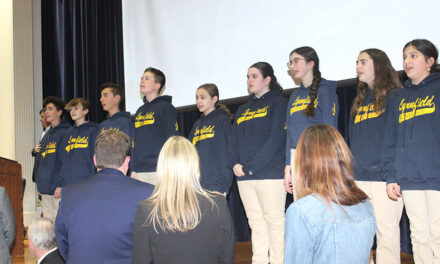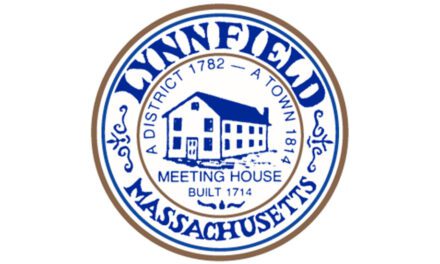Published June 3, 2020
By DAN TOMASELLO
LYNNFIELD — School officials will be developing a plan to help students get caught up once they return to the classroom this fall.
The Administrative Leadership Team appeared before the School Committee during a Zoom teleconference on May 26, where officials gave an overview of the strategic plan and the school improvement plans for the 2020-2021 academic year. Superintendent Jane Tremblay, who is retiring at the end of the month, noted that incoming Superintendent Kristen Vogel will be working with school administrators in order to develop a reentry plan once students return to school this fall.
“The reentry plan will be written later in the summer as Kristen and the Administrative Leadership Team get more guidance from the governor and the commissioner of education,” said Tremblay. “The number one thing I want parents, families and the School Committee to know is that document will trump the district strategy and the school improvement plans. Our number one priority is having our students, educators and staff back in the buildings, and having them work productively in a way that is safe and healthy.”
Tremblay reiterated the fact that officials “don’t know what school is going to look like in September.”
“We don’t know if we are going to need gloves and masks, and we don’t know if we are going to be able to have all of our children in the buildings at the same time,” said Tremblay. “We are waiting to see how the state continues to open and we will be getting guidance from our governor and our commissioner as soon as they tell us what is safe for our students and our teachers. There are still a lot of unknowns.”
In response to a question from School Committee member Phil McQueen, Tremblay said Gov. Charlie Baker and Education Commissioner Jeff Riley have yet to provide any information about the next school year to superintendents across the state.
“I think they are waiting to see how the different reopening phases go,” Tremblay. “Families are waiting with bated breath because everyone is very anxious about what is going to happen in September. I know that the reentry plan will focus on the social-emotional well-being of our students because we are very worried about our students. They need to be with their friends and their peers, and they are not for the most part. The plan will also address how we are going to assess the academics that were missed along the way. I know those components will be on the plan. What we don’t know is how many kids can be in a room, and how many students and teachers we can have in a building.”
School improvement plans
Tremblay said school officials decided to continue utilizing the strategic plan and school improvement plans next year because they outline several focus areas for the schools.
“That work will most likely be put on hold in the coming months,” said Tremblay. “The district strategy is the roadmap we use in order to move our district forward. Our school improvement plans are a direct branch of the district strategy, and they are designed to move our schools forward.”
Similar to the last few years, each school’s improvement plan includes a goal pertaining to social-emotional learning. Tremblay said the goals will help students understand the importance of having structure and routine.
“Structure and routine leads to discipline,” said Tremblay. “Not having structure and routine can lead to bad habits, which are not good.”
Huckleberry Hill School Principal Melissa Wyland said she and Summer Street School Principal Dr. Karen Dwyer worked collaboratively while crafting the plan for each elementary school.
“We are super excited about the fact that our staff has built strong relationships that are stronger than ever, and we are excited about how this collaboration will continue to grow moving forward,” said Wyland. “Many of our action items are similar to last year’s plans because we weren’t able to accomplish everything we set out to do because of the COVID-19 shutdown.”
Dwyer said the elementary schools’ educators “believe in culminating innovative and creative learners.”
“The way that we do that in elementary school is by fostering connections,” said Dwyer. “We need to foster a sense of community throughout the whole school because that is what students are craving. And once they have that foundation, they will be able to learn.”
Dwyer said the two elementary schools will be looking to highlight cultural diversity next year.
Principal Stephen Ralston said Lynnfield Middle School will be implementing the second year of its Advisory program next year.
“The idea behind the Advisory program is to build relationships between students and staff,” said Ralston. “That is now more important than ever. We can’t wait to get back in and reestablish those relationships and build some new ones as well.”
Middle School Assistant Principal Tom Sallee said LMS was unable to implement the Signs of Suicide (SOS) curriculum framework in eighth grade this year due to the shutdown. He said the goal is to implement the program next year. The SOS program seeks to help staff and students recognize students who might be suicidal.
High School Assistant Principal Brian Bates said Lynnfield High implemented the SOS program in ninth grade this year. He said the high school wants to expand the program to all four grades next year.
“We saw the impact it had this year with the students and the teachers,” said Bates. “We feel expanding it will give us a greater understanding of what our students are dealing with so we can provide them with the support they need.”
Teaching and Learning Director Kevin Cyr noted each school will continue working with A Healthy Lynnfield, including recently hired Drug-Free Communities Coordinator Julie Greene. The town hired Greene after the federal government awarded Lynnfield the highly coveted $625,000 Drug-Free Communities Support Program (DFC) Grant. The town will receive $125,000 each year for five years.
“She brings a wealth of knowledge from her experience working with youth,” said Cyr.
High School Principal Bob Cleary agreed.
“We are excited about having these resources available to students,” said Cleary. “I think that will go a long way.”
In addition to the social-emotional goals, Cyr said each school will undertake the fifth year of the Understanding by Design curriculum initiative next year.
School Committee Chairman Jamie Hayman thanked the Administrative Leadership Team for working to develop the plans as well as their work with getting remote learning off the ground.
“We couldn’t ask for a better group leading our schools, leading our students and leading our teachers,” said Hayman.





